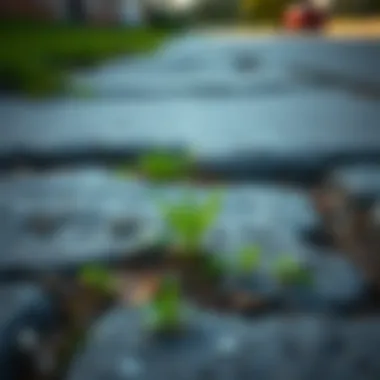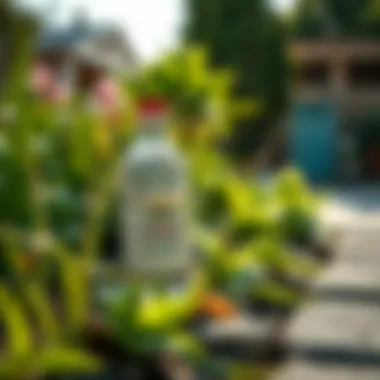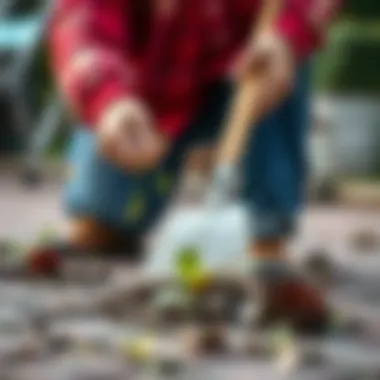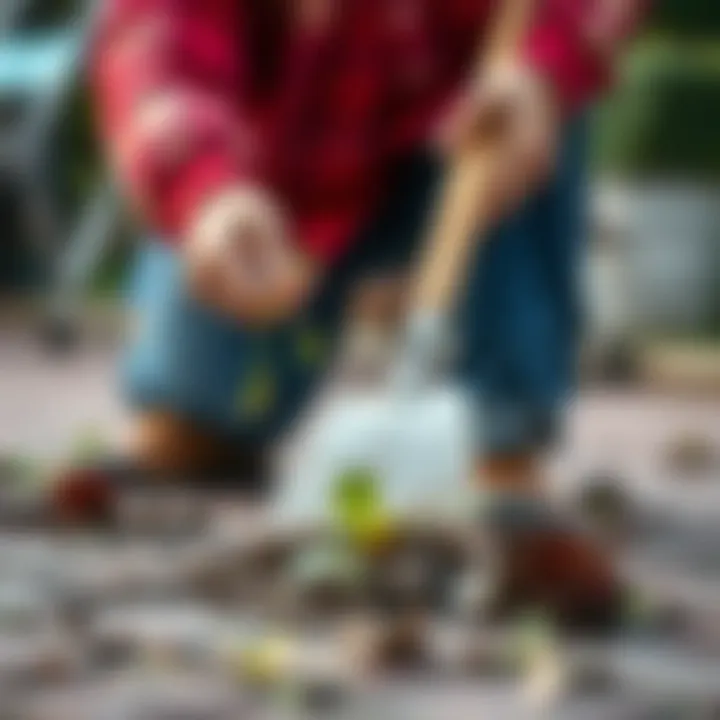Effective Strategies for Weed Control in Paved Areas


Intro
Weeds can be that pesky thorn in your side, sprouting out of the cracks in your driveway or the seams between patio stones. They don’t just spoil the view; over time, they can really wreak havoc on those paved surfaces. Removing them isn’t just about aesthetics. A weed infestation could compromise the structural integrity of your delightful outdoor spaces. If you’ve ever found yourself staring down an unruly patch of dandelions peeking from your perfect bricks, you’ll find this guide packed with practical knowledge.
This article offers a well-rounded approach that includes everything from preventative strategies for keeping those weeds at bay to effective methods for eliminating them once they’ve taken up residence. In our journey, you will discover sensible solutions—natural methods that rely on good ol' Mother Nature, chemical options for a quick fix, and manual techniques that will have you rolling up your sleeves. Whether you’re a seasoned gardener or just someone trying to spruce up the backyard, there’s something here for everyone.
Let’s dig deeper and ensure that your paved areas remain beautiful and intact, unmarred by wild invaders.
Understanding the Problem of Weeds in Paving
Weeds in paved areas can be more than just an eyesore; their persistence can lead to serious issues concerning the longevity of the surfaces we often take for granted. This section sheds light on why it's crucial to address this problem and outlines the benefits of weed eradication.
What Are Weeds?
Weeds are any plant that grows where it is not wanted, and they typically flourish in environments like cracks in sidewalks, driveways, or patios. Their ability to thrive in hostile environments often defies logic. These plants compete with our desired flora for nutrients, light, and space. Identifying them accurately forms the foundation of any eradication strategy, enabling us to take the right steps.
Common Types of Weeds Found in Paved Areas
Crabgrass
Crabgrass is notorious for its rapid growth during warmer months. This weed has broad, flat leaves that spread outward, which allows it to take over a space quickly if not managed. Its shallow roots can make it easier to pull out, but its tenacity in reseeding can complicate eradication efforts. Many homeowners find it particularly frustrating because it disrupts the aesthetic balance of their walkways.
Dandelions
Dandelions, with their bright yellow flowers, seem harmless, but they can be quite the nuisance. They possess a deep taproot, which makes them tough to remove entirely. Once they go to seed, it's a whole different ballgame, as those pesky little parachute-like seeds can spread far and wide. For some, the dandelion symbolizes resilience, but in paved areas, it's a different story; they can exert stress on the pavement structure over time.
Plantains
Plantains might be seen as beneficial in some ecological contexts, yet they can also claim their territory in paved environments. They have broad leaves that can trap debris and moisture, promoting further weed growth and even mold or mildew. Recognizing the plantain's role is essential in developing a strategy for keeping paved areas clean and functional.
Clover
Clover, often mistaken for grass, can bring a hint of greenery to shabby looking paved surfaces. While they can be beneficial for soil health, clovers may soon outstay their welcome, creating a less appealing sight as they spread. They tend to attract bees, which may be seen as an advantage in gardens but could deter folks looking for a tidy pavement.
Why Weeds Thrive in Paved Areas
Access to Nutrients
Weeds can capitalize on the nutrients found even in the tiniest of soil crevices. Often, they can extract a surprising amount of sustenance from neglected spaces that homeowners overlook. Their ability to adapt and get nourishment from arranged debris contributes to their success. This access makes a marked difference in their growth rate compared to cultivated plants.
Water Retention
Paved areas can create unique microenvironments that retain moisture. Small gaps and cracks become basins that hold water longer than intended. Favorable water conditions often lead to faster growth cycles for weeds, making it even more challenging to keep them under control. The moisture retention factor cannot be dismissed when developing effective weed eradication plans.
Sunlight Exposure
Paved areas sometimes provide perfect solar traps. The heat radiating from stone or concrete surfaces can encourage weeds to grow even when conditions in adjacent environments are less than ideal. Sunlight provides the energy required for photosynthesis, allowing these persistent plants to flourish despite adverse conditions.
The combination of nutrients, moisture, and sunlight creates the perfect storm for weeds to thrive in paved areas. Tackling these challenges requires proper strategies and consistent effort.
Understanding the complexities surrounding weeds in paved areas is an integral step in knowing how to manage them effectively. After all, knowledge is power, and when it comes to maintaining clean and appealing surfaces, it's best to arm oneself with as much information as possible.
Preventative Measures
Weeds thrive where they can, and paved areas often provide the perfect playground for them. Understanding how to prevent weeds from getting a toe-hold in such environments is essential. Focusing on preventative measures is not only about keeping your pavement looking sharp, but it's also about extending the lifespan of the surface and reducing future maintenance costs. By investing the time and effort into preventative strategies, homeowners and garden enthusiasts can save themselves future headaches.
Designing Weed-Resistant Pavements
Material Selection
When considering material selection for paving, it's crucial to choose options that discourage weed growth. For example, concrete and brick tend to resist weed penetration more than gravel or loose stones. The key characteristic of these materials is their tightly packed structure, which leaves little room for weed seeds to settle and germinate.
Many homeowners prefer concrete due to its durability and low maintenance needs. Additionally, modern innovations such as permeable paving offer water drainage benefits while still obstructing weed growth. A downside, however, is that while permeable systems allow water to infiltrate through them, they can require more periodic maintenance to prevent the buildup of debris, which may inadvertently facilitate weed growth.


Installation Techniques
In the realm of installation techniques, proper application in a weed-resistant manner can make a significant difference. One vital aspect is ensuring that pavements are laid down on a solid base, which helps prevent dips and cracks—common entry points for weeds. A beneficial choice in this stage involves thoroughly compacting the soil before laying pavers.
A well-executed installation not only helps maintain the aesthetic but also enhances structural integrity. However, rushing through this stage or overlooking drainage considerations can lead to problems down the line, such as cracking or uneven surfaces, making it easier for weeds to invade.
Regular Maintenance Practices
Routine Cleaning
The role of routine cleaning cannot be overstated in the quest to keep weeds at bay. A simple at least monthly sweeping to remove debris and dirt builds up around joints can go a long way. The characteristic of this practice is its simplicity and low cost, which fits every homeowner's budget. Soft-bristle brooms are best since they will not damage your paving but will effectively clear debris.
By cleaning regularly, you can deny weeds the materials they need to sprout. The downside, perhaps, is the time investment; however, setting a routine can help cultivate a lasting habit that pays dividends in weed prevention.
Sealing Paving Joints
Sealing paving joints is another preventative step that can significantly reduce weed growth. This technique fills gaps where weeds might otherwise take root. Using a high-quality sealant forms a barrier that limits the opportunity for weed seeds to settle in those spaces.
Many homeowners find sealing joints to be a worthwhile investment because it also helps prolong the life of the pavement by preventing erosion and water infiltration causes by freeze-thaw cycles. The drawback is the labor involved, ensuring that joints are clean and free of debris before sealing, but the benefits outweigh the troubles.
Using Barrier Methods
Geotextiles
When seeking effective barrier methods, geotextiles offer an option that's gaining traction. These fabrics are placed underneath paving surfaces to obstruct weed growth while allowing water, air, and nutrients to reach the soil. The primary characteristic of geotextiles is their permeability, which distinguishes them from other solid barriers. They serve as an effective physical barrier against weeds.
For individuals favoring a proactive approach, geotextiles can reduce long-term maintenance. However, the initial installation requires careful planning, as misplaced textiles can lead to soil erosion or other drainage issues.
Mulching
Mulching is an age-old technique that can protect paved areas while simultaneously blocking weeds. By applying organic or inorganic mulch around paved surfaces, you can reduce the chances of weed sprouting. The central benefit of mulching lies in its multifaceted approach; it not only suppresses weeds but also helps retain moisture in the soil.
However, one should be cautious with choosing the right type of mulch. Organic mulches can decompose and require frequent replenishing, which might be a hassle for some homeowners. In contrast, inorganic options last longer but may not provide the same soil health benefits.
Manual Removal Techniques
In maintaining the charm and integrity of paved spaces, adopting manual weed removal techniques can play a crucial role. Thise method not only allows for direct engagement with the problem but also offers several benefits such as minimizing chemical use and promoting a healthier ecosystem in your yard. With care and attention, you can effectively combat the unwanted greenery while ensuring the safety of surrounding plants and wildlife. Understanding the specific traits of the weeds and the various methods to tackle them manually can lead to better results and reduce the risk of re-growth.
Identifying the Weeds
Before you embark on any weeding journey, it’s vital to know what you’re up against. Different types of weeds have unique characteristics and growth patterns. For instance, crabgrass tends to sprout in late spring, spreading quickly to dominate the area. Meanwhile, dandelions are known for their persistence, reappearing every year unless handled properly. Knowing these plants is half the battle because identifying them early allows targeted action, which increases your chances of a successful eradication.
Hand Pulling
Hand pulling is one of the oldest and simplest methods of weed removal. It involves grasping the weed at its base and pulling it out of the soil. This technique is not only effective but also encourages a more thorough removal of the plant, including its roots.
Best Practices
When employing hand pulling, follow these best practices:
- Pull after rain: Soil that is moist tends to allow for easier removal, enabling you to get the entire root system out.
- Choose the right time: Targeting weeds in their early growth stage can be beneficial as they are easier to pull before they set seeds.
- Be gentle: Yanking too hard might break the weed, leaving roots behind. A slow, steady pull is often more successful.
These practices ensure you remove the entire weed without damaging surrounding plants, leading to better overall results.
Tools to Use
Although hand pulling requires minimal tools, some can enhance the effectiveness of the process. Having gloves on is crucial for protecting your hands from thorns or stinging plants. Additionally, a hand trowel can assist in loosening the soil around stubborn roots.
- Gloves: Protect against irritation and provide better grip.
- Trowels: Useful for digging out weeds with deeper roots.
Employing these tools not only makes the task safer but also more efficient, thereby improving your success rate in combating weeds in your paved areas.
Using a Weeding Tool


Another effective technique involves the use of specialized weeding tools. These tools are designed specifically to help remove weeds with less strain on the body and more precision.
Types of Weeding Tools
There are several options here:
- Weeding forks: These devices have sharp tines that separate the weed from the soil effectively.
- Dandelion removers: Specifically targeted at those persistent weeds, these tools help you access the root without much effort.
- Hoe: A traditional choice that can cultivate the soil while disrupting weed growth.
Using these tools not only makes the work easier but allows for a more thorough extraction of various types of weeds. They are ideal choices that contribute positively toward the overall goal of maintaining your paved areas.
Application Techniques
Techniques for using these tools vary but generally involve:
- Assessing weed proximity: Determine how close the weeds are to desired plants to avoid collateral damage.
- Using steady pressure: With tools like forks or dandelion removers, inserting them deeper into the ground can often yield a more successful removal of the root system.
- Follow-up care: After pulling weeds, it's important to clean the area. This may involve raking up the weeds you've removed, as leaving remnants can encourage re-growth.
By learning the proper application techniques, you can not only clear your paved areas of unsightly weeds but also maintain the overall quality and aesthetics of your space.
Chemical Solutions
Chemical methods of weed eradication play a significant role in tackling the challenge of unwanted plant growth in paved areas. While preventative measures and manual techniques have their place, the efficiency of chemical solutions can rapidly enhance the battle against persistent weeds. These solutions can often provide fast results and can be tailored to target specific weed types without disrupting surrounding plants, making them an appealing choice for many homeowners and gardeners alike.
Selective Herbicides
How They Work
Selective herbicides specifically target certain plants while leaving others unscathed. This makes them particularly valuable when the weeds at hand are a nuisance but the surrounding flora needs to remain intact. The way these herbicides operate is by identifying and disrupting processes in the unwanted plants that differ from those in desirable vegetation. These herbicides generally interfere with specific growth pathways, such as amino acid synthesis, making them effective while maintaining overall plant health in the paving vicinity.
One key characteristic of selective herbicides is their specificity. This ability to pinpoint and eliminate particular weeds, like dandelions or clover, without harming more delicate nearby flowers, places them as a popular choice for many.
Nevertheless, they may come with some downsides. It's vital to apply them correctly and to choose a product that's truly selective for the weeds you want to eradicate. Misuse or applying to the wrong types of weeds may lead to disappointed results.
Application Methods
Application methods of selective herbicides can vary significantly. Spraying is one of the most common techniques, involving direct application to the foliage of the weed. This method ensures that the active ingredients penetrate the leaf surface, where they’re absorbed and transported throughout the plant.
The precise spray approach helps prevent drift, reducing exposure to surrounding plants. Additionally, applying during the plant's growth phase when the foliage is lush can maximize effectiveness. A notable characteristic of this method is its convenience; pre-mixed solutions are widely available at garden centers, making it easy for average users to access effective weed management.
However, there are shortcomings. Ideally, one should avoid application during windy conditions to prevent overspray. Furthermore, a failure to follow label instructions might not only hinder the herbicide's effectiveness but also lead to environmental harm. Safe management is essential to fully benefit from these chemical solutions.
Non-Selective Herbicides
Advantages and Disadvantages
Non-selective herbicides act aggressively against all green plants they come in contact with. Known for their strength, they’re effective in reducing substantial weed populations rapidly. The main advantage lies in their broad-spectrum nature, which means they can clear out entire patches of weeds quickly.
This feature makes them an excellent choice for paths and patio areas that have become overrun. However, there exists a notable disadvantage: they kill indiscriminately. Thus, one must be careful when using them around desirable garden plants or grass, as unintended damage can occur.
In this context, weighing the urgency of weed removal against the potential loss of desirable plants is vital for effective decision-making.
Safety Precautions
When deploying non-selective herbicides, safety is paramount. Protecting oneself and others from exposure should always be prioritized. Wearing gloves, goggles, and a mask is essential to avoid direct contact, while ensuring good ventilation during the application process also helps. Moreover, the use of barriers to shield non-target plants can drastically minimize unwanted effects.
An important point to remember is that even after application, residues may linger in the area, so it is often recommended to keep pets and children away for a period to ensure safety. Learning about and understanding the timing of application can also make a difference in overall safety and effectiveness.
Organic Alternatives
Vinegar Solutions
Vinegar solutions present an organic alternative to traditional chemical herbicides. Containing acetic acid, vinegar acts as a desiccant, effectively drying out the leaves of weeds upon contact. This method can be incredibly handy for quick cleanup of paved surfaces where weeds may have taken root between bricks or cracks.
Another appealing feature of vinegar is its availability; most households have it readily on hand, making it a convenient solution. However, there are caveats. It's most effective on young weeds and can require multiple applications to completely eradicate deep-rooted plants.


Boiling Water Method
Boiling water is a surprisingly effective method for weed management. Pouring boiling water directly onto the weeds causes thermal shock, which can kill the plant almost instantly. This straightforward technique is especially useful for individual, stubborn weeds because it not only destroys the top growth but also significantly stresses the roots.
This method is particularly safe as it avoids synthetic chemicals altogether. That said, caution is necessary! Burning hot water can harm other nearby plants if not managed carefully. As a result, implementing this approach in a controlled setting is essential to maximize its benefits while minimizing risks.
Post-Eradication Care
Once the weeds have been dealt with, be it through chemical solutions, manual methods, or a combination of both, the focus should shift towards post-eradication care. This stage is crucial as it ensures the long-term effectiveness of the chosen methods. It’s not just about removing the weeds; it’s about preventing their return and maintaining the integrity of your paved surfaces.
The key elements of post-eradication care include monitoring for new growth, reinforcing the integrity of the pavement, and evaluating long-term strategies. Each of these components plays a vital role in the overall maintenance plan and can help keep your paved areas looking neat and tidy for years to come.
Monitoring for New Growth
After you've removed the weeds, staying on top of new growth is essential. It’s like the old saying goes, "A stitch in time saves nine." Regularly inspecting your paved areas will help you catch any stubborn or new sprouting weeds before they get out of hand. A keen eye can help in identifying the weeds early, allowing for timely removal with minimum effort.
Consider adopting a seasonal inspection schedule. For example, during warmer months, increase surveillance as this is when most weeds naturally thrive. If you notice any potential growth, act quickly – hand-pulling or using a targeted herbicide can be particularly effective.
Reinforcing Pavement Integrity
Repairing Joints
Repairing joints is a must-do practice after eradication of weeds. Over time, weeds can cause visible damage to joints in your pavement, resulting in cracks that threaten structural stability. A well-repaired joint not only enhances the look of the pavement but also minimizes water ingress, which can lead to further deterioration. Using materials that are comparable to the original pavement can be beneficial, as it helps to ensure cohesion and durability.
One of the advantages of repairing joints is that it reinforces the overall structure of the pavement. Stronger joints mean less room for weeds to rear their ugly heads. However, it’s essential to select the right materials to avoid any future issues of dissimilar expansion or contraction due to weather changes. The uniqueness of each repair job necessitates a tailored approach to ensure effectiveness.
Enhancing Drainage
Enhancing drainage systems around paved areas also plays a crucial role in maintaining weed-free surfaces. Poor drainage can cause pools of water to form, essentially creating a prime environment for weeds to thrive. By directing rainwater away from paved areas and installing or upgrading drainage solutions, you can prevent water accumulation that cultivates weed growth.
Good drainage systems are well-reputed for maintaining the integrity of not only the pavement but also the landscape surrounding it. Adequate drainage prevents soil erosion and reduces the need for constant weed management. However, it’s vital to regularly check your drainage systems for blockages or signs of wear, as neglect can lead to unexpected issues.
Evaluating Long-Term Strategies
Assessing Effectiveness of Methods
It’s crucial to continually assess the methods you’ve employed in eradicating and preventing weeds. What worked before may not be effective in the long run. Analyze the results and effectiveness of different techniques based on observations from monitoring. Keeping records of what methods you’ve used, including dates and weather conditions, can offer valuable insights.
One beneficial aspect of this evaluation is the ability to refine your techniques over time, leading to a more effective overall strategy. However, it’s important to remain flexible and ready to adapt methods based on changing conditions.
Adapting to Seasonal Changes
Seasonal changes can have a significant impact on weed growth patterns; thus, it’s smart to adapt your strategy accordingly. Developing an understanding of your local climate and the types of weeds that sprout during various seasons can give you a strategic edge. For instance, pre-emergent herbicides might be more effective when applied just before the popular germination time of annual weeds.
This approach not only aligns with the natural growth cycles but will also allow you to minimize intervention frequency. Being proactive and adjusting your methods can save you time and effort in the long run.
Culmination and Final Thoughts
In recognizing the persistent challenge weeds pose in paved areas, it becomes clear that effective management transcends mere aesthetics. The structural integrity of your paved surfaces is at stake, as weeds can compromise not only their appearance but also their durability. Through this article, we've explored an array of methods, from preventative measures to manual and chemical solutions, each tailored to fit diverse situations and preferences.
The importance of this topic lies in its practical significance. Maintaining paved areas isn’t just about removing unsightly weeds; it’s about safeguarding the value and functionality of your property. An effective weed management plan goes hand in hand with the longevity of your pavements, thereby reducing costly repairs and replacements in the long run. Each technique discussed provides essential insights, allowing homeowners and garden enthusiasts to tackle this issue head-on with confidence and clarity.
"An ounce of prevention is worth a pound of cure."
Summary of Effective Techniques
To recap, here’s a comprehensive summary of the effective methods we've covered:
- Manual Removal Techniques:
- Chemical Solutions:
- Preventative Measures:
- Hand pulling
- Usage of specialized weeding tools
- Selective herbicides
- Non-selective herbicides
- Organic alternatives like vinegar and boiling water
- Well-planned paving designs
- Regular maintenance practices
- Installation of barriers like mulch and geotextiles
Understanding these methods equips you to make informed decisions that best fit your own landscaping contexts.
Encouragement for Proactive Maintenance
Embracing proactive maintenance is more than a suggestion; it’s a decisive action that pays dividends. Regular attention to your paved areas not only prevents weed growth but also enhances the overall appearance of your property. Taking the time to regularly inspect, clean, and apply preventative measures can sidestep a world of headache down the road.







